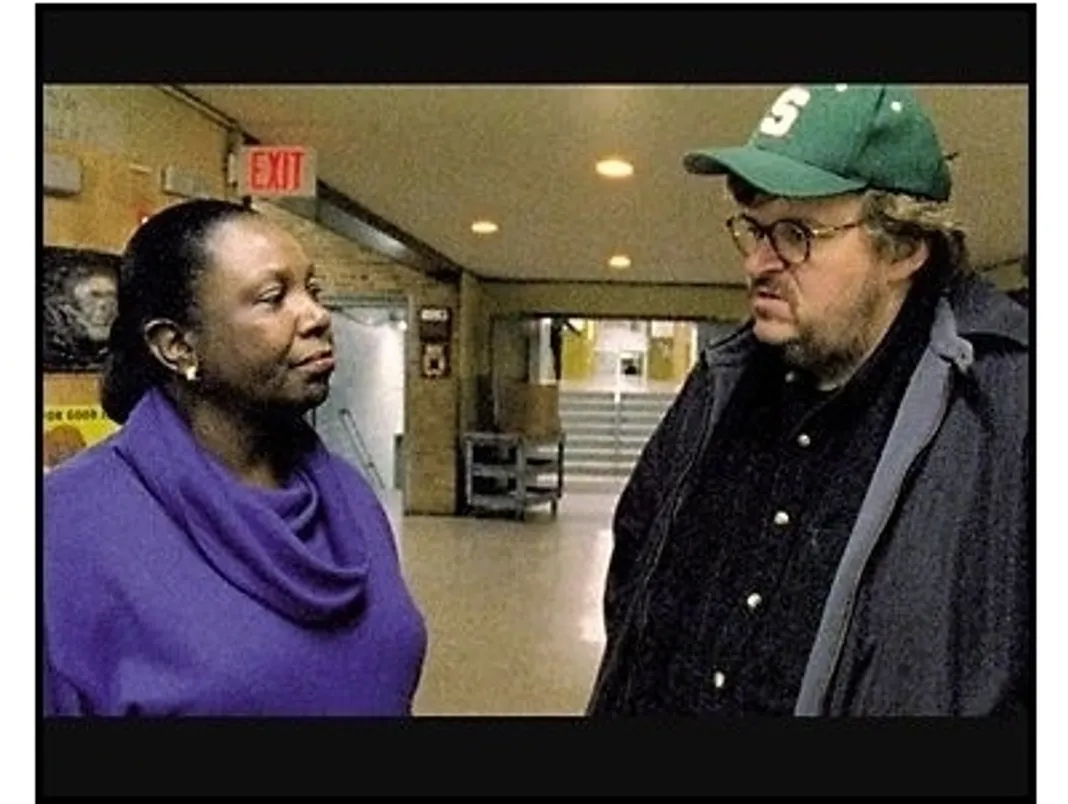Michael Moore the writer director producer and featured interviewer for Bowling for Columbine (a title best explained by the film) traverses North America searching for an answer to one question: Why do guns kill so many people in America? As he talks to the Michigan Militia Marilyn Manson Charlton Heston survivors of the shooting at Columbine High School James Nichols (that’s the brother of convicted Oklahoma City bomber Terry Nichols) and many many others Moore discovers that there is no easy answer. It’s not just because there are a lot of guns in the States; Canada has over 7 million guns in 10 million households and still has significantly fewer gun-related deaths than the U.S. For Moore much of the blame lies with the American media which perpetrates a culture of fear in order to–what else?–convince people to buy more stuff from big business which is equally responsible. If you’re afraid to walk out of your house you need a bigger TV to entertain you; if you have to leave better make sure you have a car as big as a tank to protect you. If you’re going to the grocery store better stock up on plenty of bottled water and if you’re headed for Kmart may as well pick up some–ammo?
That’s right ammunition. The troubled teens who caused such carnage at Columbine had purchased the bullets for their shooting spree at the local Kmart and in one of the film’s most incredible scenes Moore takes two survivors of the shooting to Kmart’s headquarters in Troy Mich. to “return the merchandise” that’s still embedded in their bodies. When that doesn’t get the desired response (a promise that Kmart will stop selling ammunition) the dogged threesome head to the nearest Kmart buy every bullet in the place and return to Kmart’s headquarters–this time with a hoard of reporters and news cameras behind them. Needless to say Kmart vowed to stop selling bullets for handguns within 90 days. This scene really gets at the heart of Moore‘s paradoxical position in modern culture. It’s his bulldog tenacity as a documentarian that makes his films and TV shows so interesting to watch especially when he’s forcing big business to its knees but at the same time the Kmart scene shows how Moore himself can easily fall prey to exactly the kind of media hoopla he cautions against. The media is a powerful influence; don’t trust it. The media is a powerful tool; manipulate it.
Fortunately Moore knows how tenuous his position is in this regard and as a director he makes decisions to juxtapose scenes in ways that rather than pretend the issue doesn’t exist play up the fact that as a personality on screen he’s every bit as susceptible to being accused of manipulating the medium as any local news reporter. In one particularly shocking example a reporter puts on his sad face to tell of the tragic shooting of 6-year-old Kayla Rowland by a classmate in Flint Mich. (Moore‘s hometown and also not coincidentally Moore would say the onetime home of General Motors and Eric Harris one of the Columbine shooters). As soon as the cameras stop rolling the reporter is shouting obscenities into his earpiece and whining about how much he needs some hairspray. Moore on the other hand takes his cameras inside the school to talk with the principal and he turns her away from the camera when she becomes visibly upset. But he doesn’t turn the camera off. It’s tricky. The same could be said of the film’s climactic scene in which Moore visits Heston (the personification of the film’s real villain–the NRA) at the actor’s home. Knowing now that Heston suffers from Alzheimer’s disease Moore‘s incessant questions seem too pushy and Heston‘s abrupt departure seems justified. Of course who’s to say that Heston didn’t release the information about his disease to the media this August knowing that Columbine which first screened in competition at the Cannes Film Festival in May but actually debuted in the U.S. at the Telluride Film Festival–in August–had painted him in a very unfavorable light? Although this connection seems tenuous it’s just this kind of conspiracy-minded reasoning that guides the plot of Bowling for Columbine. It can’t be coincidence Moore argues that Lockheed Martin the largest weapons manufacturer in the U.S. and possibly the world is based in–you got it–Littleton Co. home of the Columbine Rebels. It may be just a coincidence but it might just be all too true.


